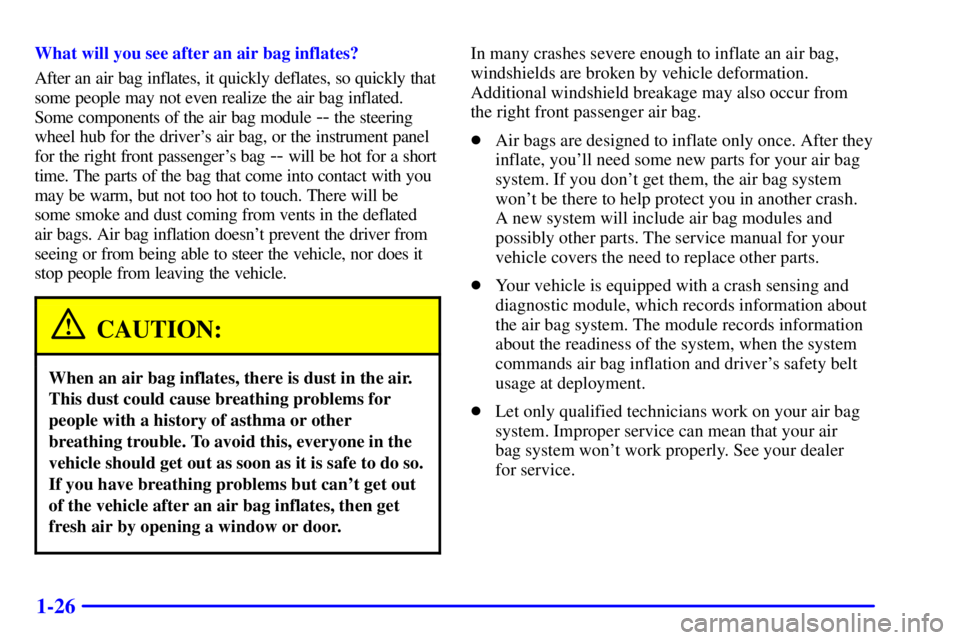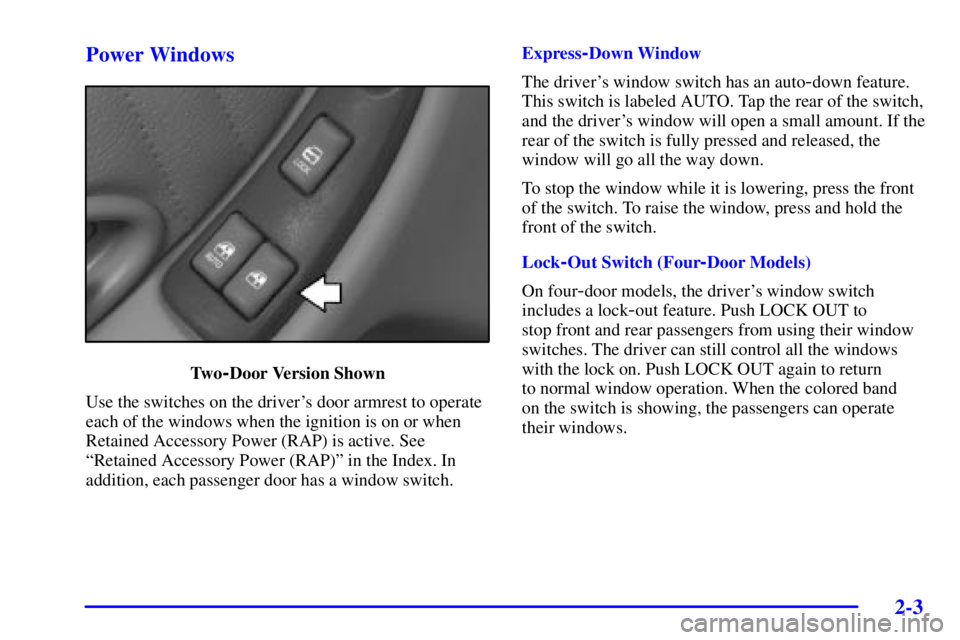Page 32 of 374

1-26
What will you see after an air bag inflates?
After an air bag inflates, it quickly deflates, so quickly that
some people may not even realize the air bag inflated.
Some components of the air bag module
-- the steering
wheel hub for the driver's air bag, or the instrument panel
for the right front passenger's bag
-- will be hot for a short
time. The parts of the bag that come into contact with you
may be warm, but not too hot to touch. There will be
some smoke and dust coming from vents in the deflated
air bags. Air bag inflation doesn't prevent the driver from
seeing or from being able to steer the vehicle, nor does it
stop people from leaving the vehicle.
CAUTION:
When an air bag inflates, there is dust in the air.
This dust could cause breathing problems for
people with a history of asthma or other
breathing trouble. To avoid this, everyone in the
vehicle should get out as soon as it is safe to do so.
If you have breathing problems but can't get out
of the vehicle after an air bag inflates, then get
fresh air by opening a window or door.
In many crashes severe enough to inflate an air bag,
windshields are broken by vehicle deformation.
Additional windshield breakage may also occur from
the right front passenger air bag.
�Air bags are designed to inflate only once. After they
inflate, you'll need some new parts for your air bag
system. If you don't get them, the air bag system
won't be there to help protect you in another crash.
A new system will include air bag modules and
possibly other parts. The service manual for your
vehicle covers the need to replace other parts.
�Your vehicle is equipped with a crash sensing and
diagnostic module, which records information about
the air bag system. The module records information
about the readiness of the system, when the system
commands air bag inflation and driver's safety belt
usage at deployment.
�Let only qualified technicians work on your air bag
system. Improper service can mean that your air
bag system won't work properly. See your dealer
for service.
Page 34 of 374
1-28
Rear Seat Passengers
It's very important for rear seat passengers to buckle up!
Accident statistics show that unbelted people in the rear
seat are hurt more often in crashes than those who are
wearing safety belts.
Rear passengers who aren't safety belted can be thrown
out of the vehicle in a crash. And they can strike others
in the vehicle who are wearing safety belts.
Rear Seat Outside Passenger Positions
Lap-Shoulder Belt
The positions next to the windows have lap
-shoulder
belts. Here's how to wear one properly.
1. Pick up the latch plate and pull the belt across you.
Don't let it get twisted.
The shoulder belt may lock if you pull the belt across
you very quickly. If this happens, let the belt go back
slightly to unlock it. Then pull the belt across you
more slowly.
Page 46 of 374
1-40
A forward-facing child seat (C-E) provides restraint for
the child's body with the harness and also sometimes
with surfaces such as T
-shaped or shelf-like shields.
A booster seat (F-G) is a child restraint designed to
improve the fit of the vehicle's safety belt system.
Some booster seats have a shoulder belt positioner,
and some high
-back booster seats have a five-point
harness. A booster seat can also help a child to see out
the window.
Page 57 of 374
1-51
Older Children
Older children who have outgrown booster seats should
wear the vehicle's safety belts.
If you have the choice, a child should sit next to a
window so the child can wear a lap
-shoulder belt and
get the additional restraint a shoulder belt can provide.
Q:What is the proper way to wear safety belts?
A:If possible, an older child should wear a
lap
-shoulder belt and get the additional restraint a
shoulder belt can provide. The shoulder belt should
not cross the face or neck. The lap belt should fit
snugly below the hips, just touching the top of the
thighs. It should never be worn over the abdomen,
which could cause severe or even fatal internal
injuries in a crash.
Accident statistics show that children are safer if they
are restrained in the rear seat.
In a crash, children who are not buckled up can strike
other people who are buckled up, or can be thrown
out of the vehicle. Older children need to use safety
belts properly.
Page 61 of 374

2-
2-1
Section 2 Features and Controls
Here you can learn about the many standard and optional features on your vehicle, and information on starting,
shifting and braking. Also explained are the instrument panel and the warning systems that tell you if everything is
working properly
-- and what to do if you have a problem.
2
-2 Windows
2
-4 Keys
2
-6 Door Locks
2
-10 Remote Keyless Entry System (If Equipped)
2
-14 Multifunction Alarm Locks and
Lighting Choices
2
-25 Trunk
2
-27 Theft
2
-28 Content Theft-Deterrent System (If Equipped)
2
-30 PASS-Key� III
2
-32 New Vehicle ªBreak-Inº
2
-33 Ignition Positions
2
-34 Starting Your Engine
2
-38 Engine Coolant Heater (Option)
2
-39 Automatic Transaxle Operation
2
-43 Parking Brake
2
-44 Shifting Into PARK (P)
2
-46 Shifting Out of PARK (P)
2
-47 Parking Over Things That Burn2
-47 Engine Exhaust
2
-48 Running Your Engine While You're Parked
2
-49 Tilt Wheel
2
-49 Turn Signal/Multifunction Lever
2
-55 Exterior Lamps
2
-57 Interior Lamps
2
-60 Mirrors
2
-64 Storage Compartments
2
-68 Accessory Power Outlet
2
-69 Auxiliary Power Connection (Power Drop)
2
-69 OnStar� System (If Equipped)
2
-73 Power Sunroof (Option)
2
-74 The Instrument Panel -- Your
Information System
2
-78 Warning Lights, Gages and Indicators
2
-91 Driver Information Center (DIC)
2
-93 Trip Computer (If Equipped)
2
-96 Head-Up Display (HUD) (Option)
Page 62 of 374
2-2
Windows
CAUTION:
Leaving children in a vehicle with the windows
closed is dangerous. A child can be overcome by
the extreme heat and can suffer permanent
injuries or even death from heat stroke. Never
leave a child alone in a vehicle, especially with the
windows closed in warm or hot weather.
Page 63 of 374

2-3 Power Windows
Tw o-Door Version Shown
Use the switches on the driver's door armrest to operate
each of the windows when the ignition is on or when
Retained Accessory Power (RAP) is active. See
ªRetained Accessory Power (RAP)º in the Index. In
addition, each passenger door has a window switch.Express
-Down Window
The driver's window switch has an auto
-down feature.
This switch is labeled AUTO. Tap the rear of the switch,
and the driver's window will open a small amount. If the
rear of the switch is fully pressed and released, the
window will go all the way down.
To stop the window while it is lowering, press the front
of the switch. To raise the window, press and hold the
front of the switch.
Lock
-Out Switch (Four-Door Models)
On four
-door models, the driver's window switch
includes a lock
-out feature. Push LOCK OUT to
stop front and rear passengers from using their window
switches. The driver can still control all the windows
with the lock on. Push LOCK OUT again to return
to normal window operation. When the colored band
on the switch is showing, the passengers can operate
their windows.
Page 64 of 374
2-4
Keys
CAUTION:
Leaving children in a vehicle with the ignition
key is dangerous for many reasons. A child or
others could be badly injured or even killed.
They could operate the power windows or other
controls or even make the vehicle move. Don't
leave the keys in a vehicle with children.